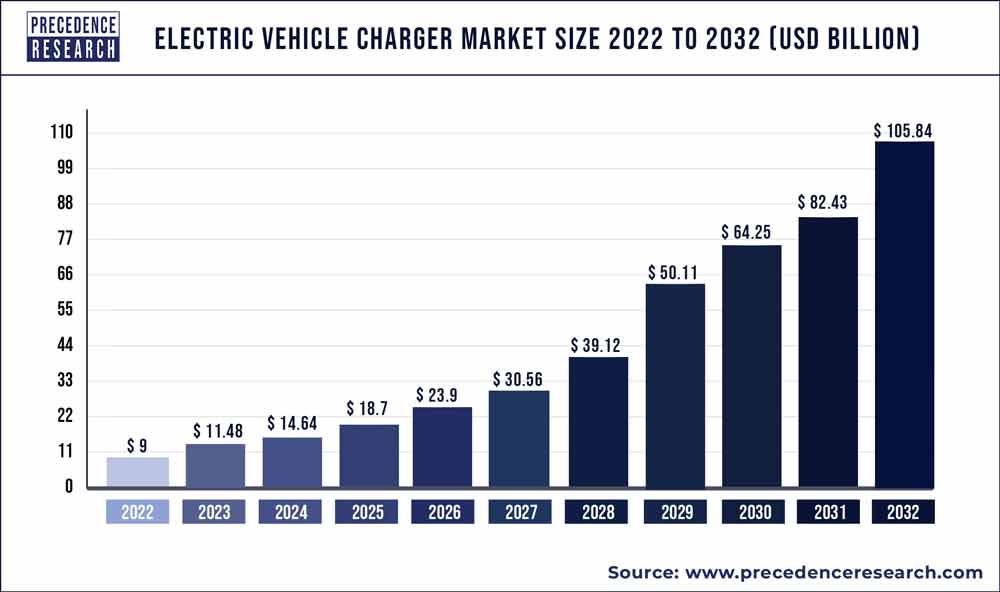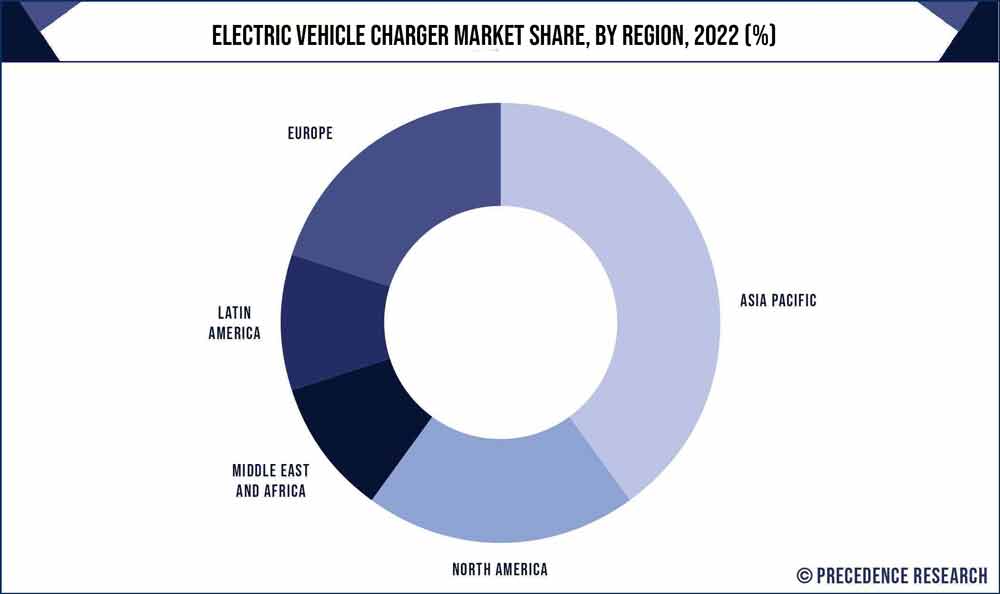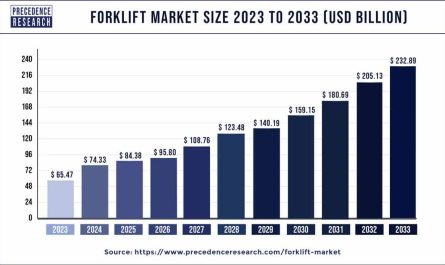The electric vehicle (EV) charger market size reached USD 9 billion in 2022 and it is predicted to touch around USD 105.84 billion by 2032 with a CAGR of 28% between 2023 and 2032.

The demand for the EV chargers is expected to grow at a significant pace in the upcoming years owing to the rising demand for the electric and alternative fuel vehicles across the globe. The rising concerns related to carbon emission from vehicles, climate change, and rising air pollutions has shifted the focus towards the adoption of the clean and green energy. This is a major factor that has driven the demand for the electric vehicles.
Get the Sample Pages of Report@ https://www.precedenceresearch.com/sample/1658
Furthermore, the government incentives and subsidies provided to the customers to purchase electric vehicles is playing an exceptional role towards the increase in the adoption of the electric vehicles. In Japan, the government is offering US$ 1,800 for buying PHEV and US$ 3,700 for purchasing BEV. Further, the Canada government is proving US$ 3,700 for buying electric vehicles to the consumers. This is fueling the sales of the EVs, which is significantly boosting the growth of the EV charger market across the globe.
Report Highlights
- Based on the vehicle type, the PHEV segment dominated the global EV charger market in 2020. The increasing government efforts to promote the adoption of the electric vehicles have played an important role in the growth of the EV charger market. The PHEVs has witnessed an increase in sales in the past few years. For instance, in January 2020, Volkswagen Group revealed that it is planning to boost its production of PHEVs by 60% as compared to that in the year 2018.
- On the basis of charger type, the on-board charger segment led the global EV charger market in 2020. The ease of use, convenience, and easy availability of the AC power has fueled its adoption across the globe. The AC charger’s flexibility and easy availability in the residential sector of the urban cities has led to the dominance of this segment.
- Depending on the end use, the residential segment dominated the market in 2020. The rising number of residential complexes equipped with advanced EV charging facilities in the parking spaces has resulted in the growth of the EV charger market in the past few years.
Regional Snapshot
Asia Pacific region dominated the global EV charger market in 2020. The presence of huge population, increased pollution levels owing to industrialization and rapid urbanization, rising disposable income, growing government initiatives, rising consumer awareness, and rising environment consciousness among consumers are some of the prominent factors that has driven the growth of the Asia Pacific EV charger market. The improved standard of living and high demand for personal commute solutions is driving the sales of the electric vehicles. Furthermore, the establishment of several top manufacturers in the region is facilitating the growth of the EV charger market in this region.

Europe is the second largest EV charger market. The consumer awareness regarding carbon footprint is high and the demand for the sustainable products like electric vehicles is also high. The presence of several top EVs manufacturers and the higher investments in building the EV charging infrastructure has led to the growth of the Europe EV charger market.
Read More: Electric Truck Market Size to Hit USD 20.25 Bn by 2032
Market Dynamics
Driver
Burgeoning sales of electric vehicles across the globe
The globe has witnessed record high sales of electric vehicles in 2020. In 2020, there were around 3 million electric vehicles were sold across the globe despite the COVID-19 pandemic. The top manufacturers of EV such as Ford, BMW, Volkswagen, Tesla, and General Motors are increasing their investments in the expansion of manufacturing facilities and research & development. Therefore, the rising sales of the electric vehicles are expected to drive the demand for the EV chargers across the globe during the forecast period.
Restraint
High costs of the electric vehicles
There is a high acquisition cost associated with the electric vehicles. The electric vehicles are new to the market and the initial costs is high, which is limiting the low and middle income consumers to adopt the electric vehicles. This is also hindering the sale of the EV chargers in the residential sector.
Opportunity
Declining costs of battery
With the rapid investments in the research and development and technological advancements, the costs of the batteries is declining significantly. This is reducing the cost of travel and is promoting the adoption of electric vehicles.The price of the EV batteries reduced from US$1,100 per kWh in 2010 to US$137 per kWh in 2020. Therefore, travelling with electric vehicles is expected to become economical in the forthcoming future, which will propel the adoption of the electric vehicles and hence, the demand for the EV chargers is expected to soar.
Challenge
Lack of infrastructure
The developing and underdeveloped countries are characterized by the presence of poor infrastructure. The low financial capabilities of the government is restricting them to invest on the development of the EV charging infrastructure. Moreover, the lack of electrification in the rural areas may limit the adoption of the electric vehicles. Hence, the lack of proper infrastructure may restrict the growth of the EV charger market.
Recent Developments
The EV charger market is moderately fragment owing to the presence of several top market players. These market players are constantly involved in the various developmental strategies such as partnerships, mergers, acquisitions, collaborations, new product launches, and various others to strengthen their position and increase their market share.
Some of the prominent players in the global EV charge market include:
- ABB Ltd.
- Robert Bosch GmbH
- Siemens AG
- Delphi Automotive
- Chroma ATE
- Aerovironment Inc.
- Silicon Laboratories
- Chargemaster PLC
- Schaffner Holdings AG
- POD Point
Market Segmentation
By Vehicle Type
- Plug-in Hybrid Vehicle (PHEV)
- Battery Electric Vehicle (BEV)
- Hybrid Electric Vehicle (HEV)
By Charging Type
- On-board Charger
- Off-board Charger
By End User
- Residential
- Commercial
By Geography
- North America
- Europe
- Asia-Pacific
- Latin America
- Middle East & Africa (MEA)
Table of Content
Chapter 1. Introduction
1.1. Research Objective
1.2. Scope of the Study
1.3. Definition
Chapter 2. Research Methodology
2.1. Research Approach
2.2. Data Sources
2.3. Assumptions & Limitations
Chapter 3. Executive Summary
3.1. Market Snapshot
Chapter 4. Market Variables and Scope
4.1. Introduction
4.2. Market Classification and Scope
4.3. Industry Value Chain Analysis
4.3.1. Raw Material Procurement Analysis
4.3.2. Sales and Distribution Channel Analysis
4.3.3. Downstream Buyer Analysis
Chapter 5. COVID 19 Impact on Electric Vehicle Charger Market
5.1. COVID-19 Landscape: Electric Vehicle Charger Industry Impact
5.2. COVID 19 – Impact Assessment for the Industry
5.3. COVID 19 Impact: Global Major Government Policy
5.4. Market Trends and Opportunities in the COVID-19 Landscape
Chapter 6. Market Dynamics Analysis and Trends
6.1. Market Dynamics
6.1.1. Market Drivers
6.1.2. Market Restraints
6.1.3. Market Opportunities
6.2. Porter’s Five Forces Analysis
6.2.1. Bargaining power of suppliers
6.2.2. Bargaining power of buyers
6.2.3. Threat of substitute
6.2.4. Threat of new entrants
6.2.5. Degree of competition
Chapter 7. Competitive Landscape
7.1.1. Company Market Share/Positioning Analysis
7.1.2. Key Strategies Adopted by Players
7.1.3. Vendor Landscape
7.1.3.1. List of Suppliers
7.1.3.2. List of Buyers
Chapter 8. Global Electric Vehicle Charger Market, By Vehicle
8.1. Electric Vehicle Charger Market, by Vehicle Type, 2023-2032
8.1.1. Plug-in Hybrid Vehicle (PHEV)
8.1.1.1. Market Revenue and Forecast (2020-2032)
8.1.2. Battery Electric Vehicle (BEV)
8.1.2.1. Market Revenue and Forecast (2020-2032)
8.1.3. Hybrid Electric Vehicle (HEV)
8.1.3.1. Market Revenue and Forecast (2020-2032)
Chapter 9. Global Electric Vehicle Charger Market, By Charging Type
9.1. Electric Vehicle Charger Market, by Charging Type, 2023-2032
9.1.1. On-board Charger
9.1.1.1. Market Revenue and Forecast (2020-2032)
9.1.2. Off-board Charger
9.1.2.1. Market Revenue and Forecast (2020-2032)
Chapter 10. Global Electric Vehicle Charger Market, By End User
10.1. Electric Vehicle Charger Market, by End User, 2023-2032
10.1.1. Residential
10.1.1.1. Market Revenue and Forecast (2020-2032)
10.1.2. Commercial
10.1.2.1. Market Revenue and Forecast (2020-2032)
Chapter 11. Global Electric Vehicle Charger Market, Regional Estimates and Trend Forecast
11.1. North America
11.1.1. Market Revenue and Forecast, by Vehicle (2020-2032)
11.1.2. Market Revenue and Forecast, by Charging Type (2020-2032)
11.1.3. Market Revenue and Forecast, by End User (2020-2032)
11.1.4. U.S.
11.1.4.1. Market Revenue and Forecast, by Vehicle (2020-2032)
11.1.4.2. Market Revenue and Forecast, by Charging Type (2020-2032)
11.1.4.3. Market Revenue and Forecast, by End User (2020-2032)
11.1.5. Rest of North America
11.1.5.1. Market Revenue and Forecast, by Vehicle (2020-2032)
11.1.5.2. Market Revenue and Forecast, by Charging Type (2020-2032)
11.1.5.3. Market Revenue and Forecast, by End User (2020-2032)
11.2. Europe
11.2.1. Market Revenue and Forecast, by Vehicle (2020-2032)
11.2.2. Market Revenue and Forecast, by Charging Type (2020-2032)
11.2.3. Market Revenue and Forecast, by End User (2020-2032)
11.2.4. UK
11.2.4.1. Market Revenue and Forecast, by Vehicle (2020-2032)
11.2.4.2. Market Revenue and Forecast, by Charging Type (2020-2032)
11.2.4.3. Market Revenue and Forecast, by End User (2020-2032)
11.2.5. Germany
11.2.5.1. Market Revenue and Forecast, by Vehicle (2020-2032)
11.2.5.2. Market Revenue and Forecast, by Charging Type (2020-2032)
11.2.5.3. Market Revenue and Forecast, by End User (2020-2032)
11.2.6. France
11.2.6.1. Market Revenue and Forecast, by Vehicle (2020-2032)
11.2.6.2. Market Revenue and Forecast, by Charging Type (2020-2032)
11.2.6.3. Market Revenue and Forecast, by End User (2020-2032)
11.2.7. Rest of Europe
11.2.7.1. Market Revenue and Forecast, by Vehicle (2020-2032)
11.2.7.2. Market Revenue and Forecast, by Charging Type (2020-2032)
11.2.7.3. Market Revenue and Forecast, by End User (2020-2032)
11.3. APAC
11.3.1. Market Revenue and Forecast, by Vehicle (2020-2032)
11.3.2. Market Revenue and Forecast, by Charging Type (2020-2032)
11.3.3. Market Revenue and Forecast, by End User (2020-2032)
11.3.4. India
11.3.4.1. Market Revenue and Forecast, by Vehicle (2020-2032)
11.3.4.2. Market Revenue and Forecast, by Charging Type (2020-2032)
11.3.4.3. Market Revenue and Forecast, by End User (2020-2032)
11.3.5. China
11.3.5.1. Market Revenue and Forecast, by Vehicle (2020-2032)
11.3.5.2. Market Revenue and Forecast, by Charging Type (2020-2032)
11.3.5.3. Market Revenue and Forecast, by End User (2020-2032)
11.3.6. Japan
11.3.6.1. Market Revenue and Forecast, by Vehicle (2020-2032)
11.3.6.2. Market Revenue and Forecast, by Charging Type (2020-2032)
11.3.6.3. Market Revenue and Forecast, by End User (2020-2032)
11.3.7. Rest of APAC
11.3.7.1. Market Revenue and Forecast, by Vehicle (2020-2032)
11.3.7.2. Market Revenue and Forecast, by Charging Type (2020-2032)
11.3.7.3. Market Revenue and Forecast, by End User (2020-2032)
11.4. MEA
11.4.1. Market Revenue and Forecast, by Vehicle (2020-2032)
11.4.2. Market Revenue and Forecast, by Charging Type (2020-2032)
11.4.3. Market Revenue and Forecast, by End User (2020-2032)
11.4.4. GCC
11.4.4.1. Market Revenue and Forecast, by Vehicle (2020-2032)
11.4.4.2. Market Revenue and Forecast, by Charging Type (2020-2032)
11.4.4.3. Market Revenue and Forecast, by End User (2020-2032)
11.4.5. North Africa
11.4.5.1. Market Revenue and Forecast, by Vehicle (2020-2032)
11.4.5.2. Market Revenue and Forecast, by Charging Type (2020-2032)
11.4.5.3. Market Revenue and Forecast, by End User (2020-2032)
11.4.6. South Africa
11.4.6.1. Market Revenue and Forecast, by Vehicle (2020-2032)
11.4.6.2. Market Revenue and Forecast, by Charging Type (2020-2032)
11.4.6.3. Market Revenue and Forecast, by End User (2020-2032)
11.4.7. Rest of MEA
11.4.7.1. Market Revenue and Forecast, by Vehicle (2020-2032)
11.4.7.2. Market Revenue and Forecast, by Charging Type (2020-2032)
11.4.7.3. Market Revenue and Forecast, by End User (2020-2032)
11.5. Latin America
11.5.1. Market Revenue and Forecast, by Vehicle (2020-2032)
11.5.2. Market Revenue and Forecast, by Charging Type (2020-2032)
11.5.3. Market Revenue and Forecast, by End User (2020-2032)
11.5.4. Brazil
11.5.4.1. Market Revenue and Forecast, by Vehicle (2020-2032)
11.5.4.2. Market Revenue and Forecast, by Charging Type (2020-2032)
11.5.4.3. Market Revenue and Forecast, by End User (2020-2032)
11.5.5. Rest of LATAM
11.5.5.1. Market Revenue and Forecast, by Vehicle (2020-2032)
11.5.5.2. Market Revenue and Forecast, by Charging Type (2020-2032)
11.5.5.3. Market Revenue and Forecast, by End User (2020-2032)
Chapter 12. Company Profiles
12.1. ABB Ltd.
12.1.1. Company Overview
12.1.2. Product Offerings
12.1.3. Financial Performance
12.1.4. Recent Initiatives
12.2. Robert Bosch GmbH
12.2.1. Company Overview
12.2.2. Product Offerings
12.2.3. Financial Performance
12.2.4. Recent Initiatives
12.3. Siemens AG
12.3.1. Company Overview
12.3.2. Product Offerings
12.3.3. Financial Performance
12.3.4. Recent Initiatives
12.4. Delphi Automotive
12.4.1. Company Overview
12.4.2. Product Offerings
12.4.3. Financial Performance
12.4.4. Recent Initiatives
12.5. Chroma ATE
12.5.1. Company Overview
12.5.2. Product Offerings
12.5.3. Financial Performance
12.5.4. Recent Initiatives
12.6. Aerovironment Inc.
12.6.1. Company Overview
12.6.2. Product Offerings
12.6.3. Financial Performance
12.6.4. Recent Initiatives
12.7. Silicon Laboratories
12.7.1. Company Overview
12.7.2. Product Offerings
12.7.3. Financial Performance
12.7.4. Recent Initiatives
12.8. Chargemaster PLC
12.8.1. Company Overview
12.8.2. Product Offerings
12.8.3. Financial Performance
12.8.4. Recent Initiatives
12.9. Schaffner Holdings AG
12.9.1. Company Overview
12.9.2. Product Offerings
12.9.3. Financial Performance
12.9.4. Recent Initiatives
12.10. POD Point
12.10.1. Company Overview
12.10.2. Product Offerings
12.10.3. Financial Performance
12.10.4. Recent Initiatives
Chapter 13. Research Methodology
13.1. Primary Research
13.2. Secondary Research
13.3. Assumptions
Chapter 14. Appendix
14.1. About Us
14.2. Glossary of Terms
You can place an order or ask any questions, please feel free to contact at sales@precedenceresearch.com | +1 650 460 3308

